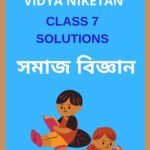SEBA Class 7 Social Science MCQ Chapter 11 Emergence of Gupta Empire Solutions in English Medium, Class 7 Social Science Multiple Choice Question Answer in English to each chapter is provided in the list so that you can easily browse throughout different chapters SEBA Class 7 Social Science MCQ Chapter 11 Emergence of Gupta Empire Notes and select need one.
SEBA Class 7 Social Science MCQ Chapter 11 Emergence of Gupta Empire
Also, you can read the SCERT book online in these sections Class 7 Social Science Objective Type Solutions by Expert Teachers as per SCERT (CBSE) Book guidelines. These solutions are part of SCERT All Subject Solutions. Here we have given Assam SEBA Class 7 Social Science Multiple Choice Notes for All Subject, You can practice these here.
Emergence of Gupta Empire
Chapter – 11
HISTORY
| MCQ |
1. Who was the founder of the Gupta Empire?
(A) Chandragupta I
(B) Samudragupta.
(C) Chandragupta II.
(D) Sri Gupta.
Answer: (D) Sri Gupta.
2. Which Gupta ruler is known as the “Napoleon of India”?
(A) Chandragupta I.
(B) Samudragupta.
(C) Chandragupta II.
(D) Kumaragupta.
Answer: (B) Samudragupta.
3. What was the capital of the Gupta Empire?
(A) Pataliputra.
(B) Ujjain.
(C) Taxila.
(D) Kannauj.
Answer: (A) Pataliputra
4. Which Chinese traveler visited India during the reign of Chandragupta II?
(A) Fa-Hien.
(B) Hiuen Tsang.
(C) I-Tsing.
(D) Marco Polo.
Answer: (A) Fa-Hien.
5. What was the primary source of revenue for the Gupta administration?
(A) Trade tariffs.
(B) Land tax.
(C) Tribute from conquered territories.
(D) Mining.
Answer: (B) Land tax.
6. Which famous Sanskrit poet and playwright was a member of the Gupta court?
(A) Valmiki.
(B) Kalidasa.
(C) Banabhatta.
(D) Tulsidas.
Answer: (B) Kalidasa.
7. Which script was used for writing Sanskrit during the Gupta period?
(A) Brahmi.
(B) Kharosthi.
(C) Devanagari.
(D) Grantha.
Answer: (A) Brahmi.
8. Which Gupta emperor was known for his extensive conquests and was also a patron of art and culture?
(A) Chandragupta I.
(B) Samudragupta.
(C) Chandragupta II.
(D) Skandagupta.
(Answer: (C) Chandragupta II.
9. What significant mathematical concept did the Gupta scholars contribute to?
(A) Zero.
(B) Pythagorean theorem.
(C) Algebra.
(D) Calculus.
Answer: (A) Zero.
10. Which Gupta ruler successfully repelled the invasions of the Huns?
(A) Chandragupta I.
(B) Samudragupta.
(C) Chandragupta II.
(D) Skandagupta.
Answer: (D) Skandagupta.
11. What was the primary material used for coinage during the Gupta period?
(A) Silver.
(B) Gold.
(C) Copper.
(D) Bronze.
Answer: (B) Gold.
12. Which religion gained significant patronage under the Gupta rulers?
(A) Jainism.
(B) Buddhism.
(C) Hinduism.
(D) Zoroastrianism.
Answer: (C) Hinduism.
13. Which work of Kalidasa is considered one of the greatest epics in Sanskrit literature?
(A) Raghuvamsha.
(B) Shakuntala.
(C) Meghaduta.
(D) Kumarasambhava.
Answer: (A) Raghuvamsha.
14. What type of administrative division was a ‘Bhukti’ in the Gupta Empire?
(A) Village.
(B) Province.
(C) District.
(D) Capital city.
Answer: (B) Province.
15. Which famous iron pillar, known for its rust-resistant composition, was erected during the Gupta period?
(A) Delhi Iron Pillar.
(B) Mehrauli Iron Pillar.
(C) Dhar Iron Pillar.
(D) Udayagiri Iron Pillar.
Answer: (B) Mehrauli Iron Pillar.

Hi! my Name is Parimal Roy. I have completed my Bachelor’s degree in Philosophy (B.A.) from Silapathar General College. Currently, I am working as an HR Manager at Dev Library. It is a website that provides study materials for students from Class 3 to 12, including SCERT and NCERT notes. It also offers resources for BA, B.Com, B.Sc, and Computer Science, along with postgraduate notes. Besides study materials, the website has novels, eBooks, health and finance articles, biographies, quotes, and more.




